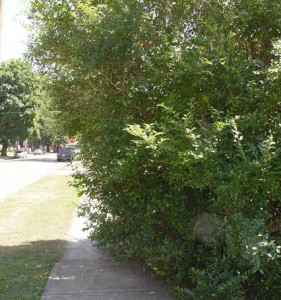 Spring is a great time to start planning for your summer pruning, trimming, and/or shearing of your shrubs. But what method is best for your landscape?
Spring is a great time to start planning for your summer pruning, trimming, and/or shearing of your shrubs. But what method is best for your landscape?
Knowing the best method to prune and trim is critical! Pruning a plant at the wrong time of year or in the wrong way can cause irreparable damage to your landscape. For example, it is more than okay to trim knockout roses with power shearers. But, if you do this to a long-stemmed rose variety, like a grandiflora, floribunda, or hybrid tea rose, you’ll ruin the plant! With that in mind, let’s define some terms…
Shrub Trimming
Normal shrub trimming involves using electric or gas-powered shearers to trim shrubs. This often gives your landscape a more uniform and even appearance. It is also the fastest and most efficient way to trim many shrubs. You should discuss with your landscape professional to determine if this method is right for you as shearing is not advised for some plant species.
Hand Pruning
Hand pruning involves selectively cutting individual stems to give your shrub a more natural shape. This service is performed with a pair of hand pruners, which look a little bit like a pair of scissors. New growth is removed to maintain its natural shape, one snip at a time. Although more time consuming and costly, this is the best option the long-term health of your plants. Hand pruning is also used to naturally thin a plant to improve air circulation and light penetration.
Pruning shrubs with this method is also used for topiaries (trimming a shrub into a specific shape). When trying to maintain that nice “spiral” shaped evergreen in a planter or flanking the front porch, hand pruning is often the way to go. It’s easier to maintain control of the hand pruners than the power shearers, and you’re less likely to damage the plant itself.
Three Things to Remember When Pruning Shrubs
Here are some guidelines for you to keep in mind when trimming your landscape plants…
1. Use sharp tools
Dull equipment can open your plants to insect or disease exposure if clean cuts are not made. You don’t want to allow your plants to contract a disease (like boxwood blight) or make them susceptible to insect damage because of bad equipment. Dull pruners or power shearers will tear the plant rather than cutting cleanly, causing undue stress on the plant and making them vulnerable.
Double check to make sure your equipment is sharp before you start. Sharpen it yourself or take it to a local professional who will sharpen for you (often your mower repair shop will perform this service).
2. Inspect clippings
Inspect clippings for any signs of disease or insects. There are several types of insect damage and diseases that will be evident upon inspection. For example, lace bug damage on your azaleas will be obvious (small, whitish circles on top of leave, small brown or black spots on the bottom). Taking a moment to look at the plant material you’ve just removed can help you identify and prevent pest and disease problems that can kill your landscape. A good rule of thumb is this: if it “doesn’t look right” to you, call a professional who can help you diagnose the issue. Local garden centers and University Agricultural Extensions can often assist you in this process, too. Here’s a link to find your local Penn State University Extension: http://extension.psu.edu/counties
3. Ask questions
Things like timing are important as well. In that example with the roses, a light trimming late in the fall is good for them, while a harder (more aggressive) trimming in early spring is also appropriate. There are also a variety of other factors to consider, such as drought conditions, and insect and disease activity as it relates to your landscape at the time of year you are looking to trim. Feel free to contact your landscape professional with any questions you may have or for more education on how to properly prune/trim your landscape.
Here to Help
We would be happy to answer any questions you have about properly trimming your landscape. Don’t hesitate to contact us for a free consultation!

